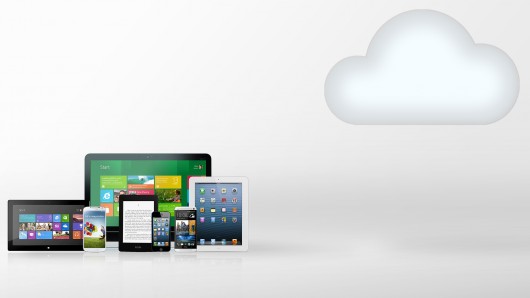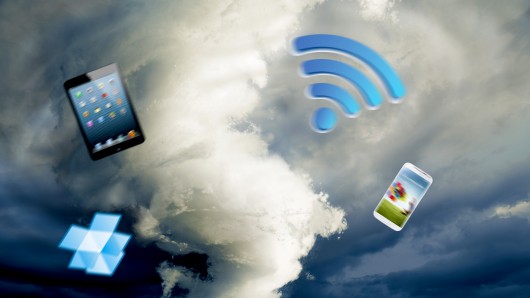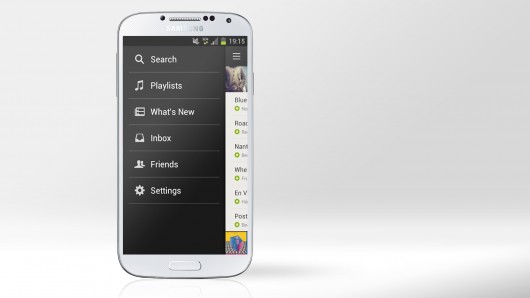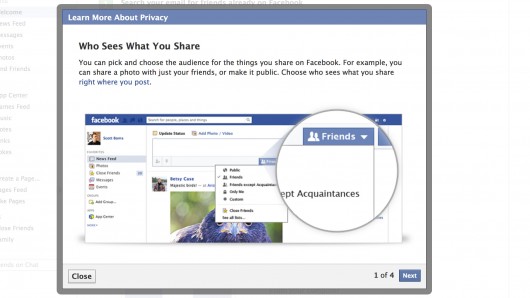
We take a step back and look at how cloud computing has changed us since going from buzzword to everyday life (image elements: Shutterstock [1] [2] [3])
In the past few years, "the cloud" has revolutionized consumer tech – nearly as much as the mobile devices that it often accompanies. But how much has it changed us? Has cloud computing lived up to the tremendous hype that it promised a few short years ago? Let’s revisit 2011’s favorite buzzword, two years later.
Sneaking up on us
A couple of years ago, the tech world was abuzz about the cloud. Cloud storage service Dropbox was growing in profit and popularity. Spotify finally hit the U.S. Even Steve Jobs used his last Apple keynote to introduce iCloud.
Sometime between then and now, the cloud went from being the next big thing to being something that’s so closely intertwined with computing – and our lives – that we often forget about it.
What is Cloud Computing?
In case you’ve been living under a rock for the last few years, a quick primer:
On a technical level, cloud computing refers to computing where the processing and/or storage takes place on a networked series of computers (usually connected via the magic of the internet), rather than on the device that you’re using.
Though “the cloud” only became a widely-used buzzword a few years ago, the roots of the cloud are traced back to the early days of computing. In the 1960s and 1970s, one powerful mainframe computer would host multiple terminals. The mainframe handled most or all of the processing, while the terminals were primarily used for input and output. The mainframe was the brain to the terminals’ limbs.
Today’s cloud is an internet-centric version of this. Now the mainframe and terminals aren’t sitting a few meters away from each other, connected by wires. Today’s mainframe is a batch (sometimes of thousands) of powerful servers. Sometimes they're on the other side of the world from the “terminals” – the millions of PCs and mobile devices logging in from all over the world.
The cloud's genius
Cloud computing takes the storage and processing limitations of any given computing device, and puts the strain on a much more powerful series of remote servers. It turns any computer into a super-computer.
Whether you’re using a PC, laptop, tablet, smartphone, television, or video game console; whether it’s running Windows, Mac, Linux, Android, iOS, Windows Phone, or BlackBerry ... everything is always waiting for you, and always in sync.
“Cloud” is an appropriate metaphor. It’s as if there’s a vaporous accumulation of data and processing power hovering in the air above you. It follows you everywhere you go (or at least everywhere that has an internet connection). To get in on the fun, all your devices have to do is turn on and tune in.
The perfect storm
During the last few years, the stars aligned to create the perfect conditions for the cloud's emergence.
The most obvious spark that created this fire was the ‘net. The rapid spread of high-speed internet – both at home and on the go – created the backbone of the cloud. No internet, no cloud. Slow internet, slow cloud. Home broadband and 4G mobile data make for a speedy, (mostly) reliable cloud.
Another huge factor was the commercial explosion of smartphones and tablets. They often have lesser storage and processing capabilities than desktop PCs, and some of them (most notably Apple’s) don’t allow direct access to the file system. This makes them the perfect match for cloud computing: their user-friendly front-end can tap into a more powerful – but invisible – backend.
Closely related is the multi-device trend. Five or six years ago, customers had – at most – two devices. Desktop PC, laptop PC. For many of us, it was just one or the other. I'd bet that the phrase “my computer” was uttered more then than it is today.
Today "computer" is plural. We have desktop PCs, laptop PCs, smartphones, big tablets, small tablets, PC-laptop hybrids, phablets, portable media players, connected TVs, TV set-top boxes, home game consoles, portable game consoles ... heck, a few wacky people even have smart fridges.
Few of us own all of these devices (especially the fridges), but more of us than ever own more than two. With all of these new devices, we needed something to bridge them all together. That glue is the cloud.
Infesting our lives
On an experience level, the cloud is many more things:
The cloud is having the entire history of recorded music – terabytes upon terabytes of data (delivered via Spotify, Rdio, iTunes Match, or some other combination of cloud music services) – at your fingertips, ready to play on an itty-bitty connected device.
The cloud is typing a research paper on your desktop PC, then immediately picking up your smartphone to take it up right where you left off ... then lounging on the couch with your tablet, and picking up from your new stopping point.
The cloud is playing the latest PC game on the highest settings – a task which would normally require an expensive gaming rig – on an underpowered smartphone.
Heck, the cloud is even using a web-based email service like Gmail. When was the last time you worried about downloading and backing up all of your emails? If you’re old enough to have ever done this, it was probably in the 20th century. The cloud guarantees that – even if you lose your local copy – there’s a backup waiting for you in the cloud.
Companies like Microsoft and Adobe are even using the cloud to help sell premium software. They take their pricey apps (like Office and Photoshop), come up with a subscription plan, and cash in. The software lives on your computer(s), but the cloud supplies some bonus storage. More importantly, the cloud tells the app whether you’re paid up on your subscription. If you aren’t, then sayonara: it deactivates itself.
Something rotten
All, however, is not peaches and cream in the cloud. The Cloud has a dark side. All of this convenience requires you to put your trust in the services that connect you to the cloud. And sometimes that trust is broken.
Earlier this month, Evernote was breached. Hackers accessed the usernames, emails, and encrypted passwords for all of the service’s users (fortunately, no widespread harm was reported). In 2012, Dropbox was similarly exploited. The year before, there was a day when anyone could log into any Dropbox account without a password. Yikes. One of the most publicized examples was in 2011, when Sony’s PlayStation Network was hacked – with 77 million accounts compromised.
Thanks, cloud.
Cloud security is still evolving. Some would even say “security” and “cloud” should never be uttered in the same sentence.
The cloud may never be 100 percent bulletproof. For your most private and sensitive information, you’re still better off playing it safe and storing it locally.
Privacy woes
You might not think of them this way, but social networks are cloud companies. In fact, they might be the most important cloud companies, because we store vivid pictures of our personal lives on their servers.
Other cloud services may store our files, documents, and passwords ... but Facebook stores our families, friends, and most important moments. It’s the most personal cloud.
So when Mark Zuckerberg dreams up a new policy that shares our lives with someone we might not want to share it with ... then that trust in the cloud is once again broken.
We make take this breach of trust even more personally. The more personal the data stored in the cloud, the more we feel like it's a personal betrayal. We treat our relationship with the cloud as if it were a relationship with another person.
Hostile DRM
At its best, the cloud enhances the customer’s experience. Some overzealous companies, however, use the cloud in ways that degrade that experience. Take EA’s recent kerfuffle with SimCity. The new version adds an always-online element to a traditional single-player game. EA won’t ever admit this, but its motive was almost certainly to combat piracy. Unfortunately, it also combats paying customers.
Not only does the always-on DRM make the game unplayable without an internet connection, but it sets the stage for outages where customers can’t access the game that they “own.” And that’s just what happened when the popular game’s launch crashed EA’s servers. Thousands of paying customers had to wait days to play, and EA suffered a PR nightmare.
To a lesser degree, Google’s recent announcement that it will shut down Google Reader sung the same song. Thousands of news junkies spent years using Reader to collect their favorite RSS feeds. You wouldn’t be crazy to have felt like your feed collection was “yours.”
But the cloud’s dark side reared its ugly head when Google abruptly announced that it washing its hands of Reader. Nope, those feeds were never yours. They were Google’s, and Google is done with Reader. Bye bye.
(in fairness to Google, you can easily export your Reader feeds to another service, but you get the point ...)
The Cloud in 2013 and beyond
The cloud isn’t without its warts. But, like it or not, it’s now firmly entrenched in our digital lives. Mobile devices get much of the credit for the big changes during the last five years, but the cloud's effects have been equally potent ... and more stealthy.
The next steps in the cloud's growth needs to be improving security and reliability. Until the, we will experience more growing pains, where companies abuse the trust that we put in them – and lead us to question the entire premise of cloud computing.
The key is for cloud companies to do everything in their power to reward their customers’ trust. The less we hear about hacks, unreliability, privacy flubs, and outages, the easier it will be to trust these companies with the digital reflections of our lives.
But until those stories are so rare that they shock us, the cloud will remain in an awkward adolescent stage. Full of promise, showing flashes of future brilliance, and sprouting some impressive facial hair ... but also inconsistent, unpredictable, and just frustrating enough that you have to take a deep breath and remember how young it is.
Disclosure: Rackspace paid Gizmag a fee for the exclusive right to advertise next to a story about cloud computing, but the tone, content and direction of the story remained the exclusive right of its author and editor.Go to the Rackspace site for more information.
Copyright © gizmag 2003 - 2013 To subscribe or visit go to: http://www.gizmag.com






